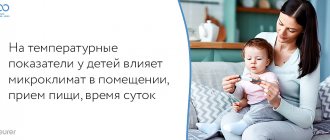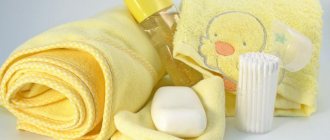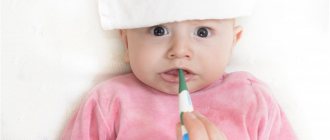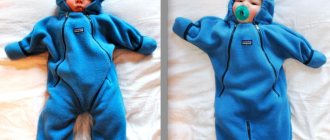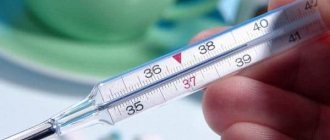23.09.2019 8653 0
Newborns and children under one year old have immature thermoregulation. The body quickly reacts to any temperature changes, clothing inappropriate for the weather, or food intake. Even prolonged crying can cause a rise in temperature! The baby's body temperature may be 0.5-1 degrees higher after sleep and feeding.
Mercury thermometer
The most accurate device, there is practically no deviation from the temperature measurement, and errors are rare and are calculated in fractions of a degree. Another advantage is the possibility of disinfection. This device can measure the temperature in the armpit, mouth and rectum.
A mercury thermometer has two disadvantages - the duration of measurement and fragility. The thermometer will have to be left in the armpit for 10 minutes, in the mouth and anus for 5 minutes, which causes difficulties when measuring temperature in infants. The thermometer is made of glass, and is filled with the substance mercury, which causes poisoning of the body. Therefore, it is important to be careful when using it, especially in children.
Reasons for deviations from the norm
The reasons for the temperature deviation may be different. These are not always diseases that require treatment. An increase in temperature, for example, accompanies the period of teething. A 4-month-old child’s temperature may rise due to overheating or being in a stuffy room. Indicators may increase after eating, a stressful situation, and even a noisy game. For this reason, you should alternate vigorous activity with quieter activities - drawing, reading books, etc.
The causes of hypothermia (decreased performance) often indicate pathological processes in the child’s body, although they can also be a consequence of even slight hypothermia.
Fever
With elevated levels, the baby refuses food, begins to cry, and his breathing quickens. He may turn red and the body becomes wet. In this case, the limbs may remain cold due to poor circulation.
There are many reasons for the increase in temperature, one of them is a reaction to vaccination. To form the body's defenses, a small portion of the antigen is introduced, with which the child's body fights, developing immunity to this disease. This type of immune function is most often accompanied by an increase in temperature.
The intensity of the reaction depends on 2 factors:
- individual characteristics of the body;
- the amount of antigen and the degree of its purification.
After immunization, the indicator may rise to 38.5°C. This reaction may appear some time after vaccination. If the temperature rises above 39°C, you should seek medical help.
There are asymptomatic causes of increased temperature readings. They are difficult to diagnose, so you should pay special attention to them:
- the presence of foreign bodies in the body;
- allergic reaction to objects that the baby comes into contact with;
- congenital heart disease, tumors, diseases associated with the endocrine system;
- headache.
In order not to miss severe pathologies with a systematic increase in temperature, you should immediately consult a doctor.
Overheating is a common cause. Even if the room is cool, but the child is tightly bundled up, he may overheat. It is better to take off your hat indoors.
Constipation and teething often lead to a slight increase in readings. In the second case, inflammation of the gums leads to an increase in temperature.
In infectious diseases, an increase in temperature is associated with the effect on the body of metabolic products and decay of pathogenic microorganisms. The duration of fever most often coincides with a period of intensive reproduction of harmful microbes in the body.
Reduced body temperature
A decrease in temperature is accompanied by paleness of the skin, and the lips and adjacent skin acquire a bluish tint. The baby may begin to swing its upper and lower limbs sharply and scream loudly.
If the temperature drops slightly (up to 35°C), and the baby feels well, then there is no need to worry. This may be an individual characteristic of the body. If the value drops below 35°C, this indicates hypothermia. In this case, you should definitely consult a doctor and conduct an examination. Most often, consultation with a pediatrician, immunologist and endocrinologist is required.
The reasons for a decrease in temperature in infants up to one year old may be as follows:
- premature birth;
- during sleep;
- against the background of a long illness;
- lack of vitamins, anemia;
- hormonal imbalances;
- after taking antipyretic drugs;
- presence of a tumor;
- hypothermia;
- severe poisoning.
If the decrease was the result of hypothermia, the baby must be warmed with warm drinks and clothing, you can put a heating pad at the feet. To avoid this phenomenon, you should maintain the required temperature in the room where the baby is located and harden the child to increase immunity.
ARVI
Common ARVI is a common cause of increased body temperature. The baby becomes restless, constantly cries, eats poorly, and begins to have diarrhea - all these are signs of intoxication.
The main symptoms of ARVI are cough and runny nose. However, infants generally experience difficulty breathing through their nose rather than experiencing heavy nasal discharge, as adults do. Therefore, the baby may begin to suck at the breast worse. With the help of elevated temperature, the baby's body fights viruses. If the temperature rises to 38 degrees, but the baby feels well, there is no need to bring it down, but if chills, muscle pain and headaches appear, you need to give the baby an antipyretic according to his age.
How to maintain your baby's temperature at the same level
In order for the baby's body temperature to be equally normal - 36.6 degrees or slightly higher, you should follow simple hygiene rules.
- The temperature in the room where the baby is located should be 20–24 degrees. It is better to hang the thermometer directly above the baby's crib. If a child is born prematurely or has a cold, the temperature in the air increases. In hot weather, the temperature should be slightly lower (up to 18 degrees).
- You shouldn't wrap your baby up too much. Clothes must be of high quality and breathable.
- During the walk, children's heads should be covered. Most of the heat leaves this part of the body.
- You can determine whether a child is hot or cold by looking at his condition. Skin color (red or vice versa, marbled), tactile sensations (cold hands or the presence of sweat), the appearance of hiccups or goose bumps.
- During the hot season, children should drink as much as possible to prevent dehydration.
What to do if your baby has a low temperature?
When the body temperature is below the permissible norm, the child becomes lethargic and capricious. To normalize his condition, it is necessary to carry out a number of measures:
- Insulate the child. Make sure that things and bedding are dry.
- Ensure the required temperature in the room (at least +20°C).
- Maintain a sleep schedule. Infants need to sleep at least 10 hours a day.
If a low body temperature persists for a long time and is accompanied by a deterioration in the baby’s condition, this can negatively affect mental and physical development. For this reason, parents should not ignore even the slightest deterioration in the child’s well-being.
Temperature readings for a three-month-old baby
The question of what normal temperature is considered in a 3-month-old child remains a conditional issue. The process of thermoregulation at this age is still not formed, so the reaction to temperature changes occurs extremely slowly. It will also be normal if the indicator fluctuates within one degree during the day. And this will depend on the activity of his behavior, what he did on the eve of thermometry (sleeping, eating, moving).
When a child is 3 months old, a temperature of 37, or more precisely 36.4-37.4 degrees Celsius, is considered normal and acceptable at this age. The main thing for the child is to be comfortable. Otherwise, he will be capricious, sweat, and show his dissatisfaction.
But a baby's body temperature is not a specific indicator of health or well-being at three months of age. So, the doctor pays attention to many other symptoms that can occur with a 3-month-old baby. So one 3-month-old child with a temperature above the specified indicator feels great, while for another it is a sign of the onset of some kind of inflammatory process in the body.
How is high temperature treated in infants?
Pediatricians do not recommend reducing fever if the thermometer shows 38.5°C or lower. When a harmful microorganism enters, the body itself is capable of producing interferon. The maximum concentration of the substance occurs on the 2nd day of disease development. If you actively reduce the fever during this period, the child’s immunity decreases, and the disease only progresses.
To lower the temperature in a child under 1 year old, the following principles should be followed:
- Create comfortable indoor conditions (no more than +20 °C).
- Moderate dressing or swaddling (the baby should neither sweat nor become cold).
- Provide plenty of fluids.
- Avoid excessive physical activity.
If the readings do not fall below 38.5°C, it is recommended to give the patient medications that reduce febrile symptoms. The safest are paracetamol-based drugs. If these remedies do not help, then ibuprofen-based medications are used.
Temperatures should be lowered with medications with caution. The dosage of drugs to reduce fever in a 3-month-old child is less than in a six-month-old baby.
It is necessary to call an ambulance in the following cases:
- a fever occurs in an infant under 3 months of age;
- on the thermometer 38.5°C and above;
- the appearance of seizures;
- tension in the cervical spine (the child cannot bend his head forward);
- noisy and rapid breathing;
- the baby cries constantly;
- refusal of food;
- vomiting and loose stools;
- change in urine color;
- rash on the skin;
- the presence of chronic pathologies;
- the temperature is not reduced by antipyretic drugs.
Before the ambulance arrives, you need to adhere to the following recommendations:
- give as much fluid as possible;
- ventilate the room where the child is (at this time, move the baby to another room);
- apply cooling compresses to your feet.
- do not wrap the baby.
Dim the lighting in the room, eliminate harsh sounds and any situations that could cause stress in a small patient.
What to consider as a cause for concern
It is better for parents to determine on their own, if the baby is feeling well, what its usual temperature is. As soon as a 3-month-old child’s temperature begins to rise above the specified maximum and exceeds 38 degrees, the disease definitely makes itself felt. However, babies who are fully breastfed are least likely to get sick. Although there may be several reasons for the process when the child’s temperature rises:
- development of an acute respiratory viral infection or cold as a result of hypothermia, contact with an infected person;
- manifestation of flu symptoms with high fever in a newborn, including a child 3 months old, which will last about three days;
- inflammatory process in the middle ear;
- runny nose with the development of sinusitis;
- pyelonephritis that developed as a result of hypothermia;
- pneumonia, that is, pneumonia, as a result of hypothermia or a cold with cough;
- the occurrence of childhood infections such as measles and rubella, whooping cough and more;
- development of food poisoning;
- teething at an early age is also considered the reason why a child’s body temperature rises at 3 months.
However, in addition to the main reasons listed, when a child’s normal temperature is replaced by an elevated one, there are others. In other cases, the doctor must give parents an answer about the health status of their children. It is better to call him as soon as the child becomes ill. In the meantime, it is better to observe hourly how many degrees there will be.
